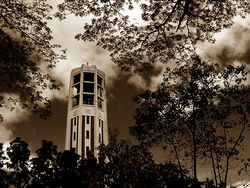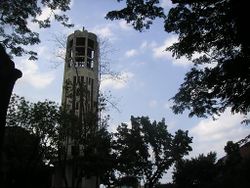Carillion: Difference between revisions
No edit summary |
Rsmoralejo (talk | contribs) |
||
(No difference)
| |||
Revision as of 17:54, 22 March 2010
Carillon
Osmena Avenue, Diliman, Quezon City, National Capital Region, Philippines
Art Studies 2 THR-2
Sir Roberto G. Paulino
Report by:
Alvin Bacero Bello
Maria Cristy Borcelis Buban
John Martin Rabino Caquilala


I. History
The University of the Philipines Memorial Campanille with its carillon of 46 perfectly tuned bronze bells was one of its kind in the far east and one around hundred in the world. It was the first carillon tower in the South East Asia and the first Carillon in a campus setting.
The plan of constructing the Carillon was envisioned in 1940 by Mr. Bienvenido Gonzalez, former UP president; Architect Juan G. Nakpil, a UP Alumnus; and Conservatory Music director, Mr. Ramon Tapales. Unfortunately, all the efforts towards its formation were paralyzed because of the World War II. However, after the country’s liberation, the plan was again brought forward at the time when the University was preparing to move from the bombed-campus in Padre Faura to the green hills of Diliman. The plan was re-envisioned at a meeting of the board of directors of the UP Alumni Association, on September 18, 1948.
The bells of the carillon were casted by the Van Bergen Bell, Chimes and Carillon Foundry, of Greenwood, South Carolina and were delivered and installed under the supervision of a Dutch Carilloneur, Prof. Adrian Antonisse, director of the Music-school of Netherlands. Professor Antonisse became the first Carilloneur of the state university. The installation started from June and the last bell was set place on July 11. The tower was constructed under the direction of Juan Nakpil, a UP Alumnus and 1973 National Artist for Architecture. This was accomplished soon after the University transferred most of the units from Manila to Diliman.
It was the alumni who decided to donate the carillon as their contribution to the new campus. But due to lack of funds, the UP Alumni Association decided to create a funding committee. The Funding Committed formulated a project involving a nationwide campaign to raise funds for the purchase of the bells and the construction of the tower. The committee sent an appeal to more than 17,000 alumni all over the country. Struck by this gesture, the UP Board of Reagents authorized an advance sum for its construction with the understanding that the alumni association will pay them back.
President Elpidio Quirino was the first to respond to call giving an amount of Php 1000. Prof. Juan Nakpil, consulting architect of the University, donate an amount of Php. 5 000 in memory of Dr. Ariston Bautista Lin. Other early donors include Juan J. Carlos, practicing engineer of Manila who gave Php 500 and Capt. Alfredo G. de la Cruz of San Miguel Tarlac, Php. 10. Php. 90 000 was the target amount from all donors including the alumni, private individuals, fraternities and student councils making the project a labor of love.
It was finally inaugurated by President Elpidio Quirino on August 1, 1952 in commemoration of the former President Manuel L. Quezon’s death.
On August 3, 1952, Prof Antonisse was presented by the UP Conservatory of Music at a carillon concert. This was followed by a farewell concert on August 14 of the same year. College of Liberal Arts and the Conservatory of Music also sponsored two identical lectures on carillon bells and music by Prof Antonisse on July 24, week before the dedication of the UP Carillon.
On the first Christmas Eve with the carillon installed, it was heard for two solid hours until midnight, ushering in the birth of our Lord. Likewise, it was hard on the early Easter morning proclaiming our Christ arisen.

II. Structure and Design
The University of the Philippines Memorial Campanile is a 130-foot structure with a carillon of 46 perfectly tuned bronze bells. The tower was built under the supervision of architect Juan Nakpil, a 1973 National Artist. The funds for its construction were provided by the UP Alumni Association and donors.
From the outside view, the tower is painted with cream and maroon. It has a very stable foundation and has a system of vertical lines topped with a small dome. A sight of an endless spiral staircase could be seen in the building’s interior.
The carillon bells were installed up in the tower with the supervision of Professor Adrian Antonisse Jr., a Dutch carilloneur and director of Veendammer Muziekschool of the Netherlands. Those bells were casted by Van Bergen Bell, Chimes and Carillon Foundry. Some of the bells were named after individual donors. The largest bell which weighs about five tons was embossed of the names of the officers and the members of the board of directors of the alumni association. The last bell was set place on July 11, 1952.
The bells were tuned to the intervals of the chromatic scale similar to a piano, and having a range of three octaves or more. The bell which has the lowest pitch can weigh many tons. The smaller the size of the bell means the higher the pitch. The names of the Alumni Board and donors are inscribed on some of the bells.
There are two methods of playing the carillon. A carilloneur may strike a keyboard called a “clavier” which is similar to that of an organ but the difference is that it uses wooden pegs. According to Prof. Antonisse, one to two years of devoted study is necessary to master the instrument which requires a great deal of muscular effort to play because the fists are used in striking the keys. Each key of the clavier is connected to the clapper of the corresponding bell by means of wires and cranks. Those clappers are sufficient to bring out the full volume of sound required for carillon playing. Pedals are also attached to the levers connected with the heavier bells so that these can be played by foot. The alternative way of playing is an automatic machine which plays the carillon at pre-set hours
| First Five Carilloneurs |
|---|
| Prof Adrian Antonisse Jr. |
| Mr. Wesley Tabayoyong |
| Cris Eva Gonzales |
| Jerry Dadap |
| Tony Regalaria |
Table 1 shows the first five Carilloneur of the University of the Philippines.
III. Symbolisms and Struggles
Carillon as a symbol of Loyalty
Since it was the alumni association who mainly contributed in the construction of the Carillon, it was established that the tower symbolizes the Alumni spirit, love and loyalty. As per Juan Nakpil, the Carillon will serve as the emotional and spiritual link between the students, faculty, and alumni of the succeeding generations. He also added, “It will be a voice speaking to us from the midst of our campus – not from a distance”
Carillon as a symbol of Extravagance
Though UP Carillon has been a symbol for Alumni’s Labor of Love, it did not escape certain issues regarding its formation and structure. During the time of its construction, the state university was also suffering from an immense financial difficulty brought about by the war. Because of this, repercussions took place for some sectors of the university objected to the formation of the Carillon calling it a symbol of extravagance and not loyalty. They contented that the money spent for its construction should have been allotted in solving the monetary problems that plagued the University.
In response to this, the editor of the Collegian in that year wrote on his article, “We do not look at it that way. To us, the Carillon is a gift of the alumni and is symbolic of their regard to the Alma Mater. To us, the Memorial Campanile is the expression of their loyalty to the cause of education which the University is dedicated. That to us is the Carillon. If loyalty ever be a luxury then the Carillon and all that it stands for is luxury, indeed”“
Most of the University Officials believed that the Carillon symbolizes very important ideas and conceptsthat are priceless and are worthy of the enormous amount spent for its construction.
Carillon being tilted
The Carillon became controversial not also because of its monetary aftermath but also because of the assumption that the lofty structure is tilted. During that time, students of the university hoped to have another leaning tower like that of the Pisa in Italy. However, a study made by a group of Engineering professors proved that it was just an optical illusion. Only after this study did the hubbub ceased.
Carillon being out of tune
Aside from the fact that the bells are tuned in chromatic intervals and have a range of three or more octaves, the overtones and the harmonics produced by the bells are also arranged in an order way different from those given by the strings or by an organ. Because of these, listeners who are not familiar with the Carillon thought that our bells are out of tune.
Defending the Carillon, Arthur L. Bigelow said, “In contrast to other producers of musical tone, endowed by nature with a major third, the third of the bell is minor. It is this particular overtone which gives to the bell its plaintive note, so characteristic and so distinctive from all other instruments”
Truly, before one can fully appreciate the music of the Carillon, he must first learn to distinguish the humtones from the overtones. As what Prof Antonisse has said in one of his lectures, “You just don’t take Carillon Music. It is entirely different from other forms of music.”
IV. Bibliography
Cabatuando, Patria "The Musical Tower". The Philippine Collegian. October 14, 1967.
Mendoza, Rene E. "The Carillon Story". The Carillon Overtones, Vol 1 No. 1 . March 1957.
"Legend of the Bells". The UP Bulletin, Vol 3 No. 2 . September 1952.
"Carillon". The UP Newsletter, pp 5-6 . October 1973.
"Carillon on the Diliman Skyline". The UP Bulletin, Vol 1 No. 4 . August 1949.
"Carilloneur Speaks on Bells and Music". The UP Bulletin, Vol 3 No. 1 . July 1952.
"Now on its way are the UP Carillon Bells". The UP Bulletin, Alumni Homecoming Volume . April 1952.
"Quirino Donates P 1,000 to Carillon". The UP Bulletin, Vol 1 No. 4 . August 1949.
"The UP Carillon Bells". UP Alumni Reunion Yearbook . 1953.
The UP Bulletin, Vol 2 No. 1 . January 1950.
Map
<googlemap lat="14.655216" lon="121.068091"></googlemap>


